I thought to write this up - it's based on a series of posts on my non-chilli website at http://lagrangianpoint.net
It's really not that complicated, but trying to source the information in one place / article can be difficult. Coupled with a lot of large gaps in explanations, or even plain misinformation. Hopefully it's useful...
Overview:
What this post should answer:
- What is Photosynthetically Active Radiation (PAR)?
- What is Photosynthetic Photon Flux (PPF) / Photosynthetic Photon Flux Density (PPFD)?
- How to convert lumen output to PPF.
- Why to steer clear of any brand/seller making claims that just don't add up.
What this post likely won't answer:
- Should I buy a grow lamp of one technology in preference of another?
- What is the best "colour" for growing chilli plants; for growth, for flowering, for fruiting?
- Any variation of the above that you can think of: red vs. blue LEDs, HPS vs. LEDs, what about green light, etc.
So strap on your favourite propeller hat, grab your spreadsheet application and on with the show...
"Problem" statement:
Input:
1. Rated (electric) input power of lamp - watts
2. Rated (light) output power of lamp - lumens
3. Spectrum of lamp
Output:
4. Photosynthetic photon flux (PPF)
3. Spectral power output
2. Luminous efficiency
1. Luminous efficacy
The basics:
Units of measure:
- Power is measured in watts (W). It is the amount of energy transferred per second (s).
(- Energy is measured in joules (J). It's one and same thing as power on a per second basis.)
- For this posting's purpose, power/energy can be transferred by electric current (electrons) or light (photons).
- Energy cannot be created or destroyed, just transformed / transferred - Law of Conservation of Energy.
- Red light has a longer wavelength, while blue light has a shorter wavelength. Also, red light photons have a lower energy than blue light photons. Conversely more red light photons are required to deliver the same power as blue light photons.
- Lumen is the power output from a lamp, referenced against the human eye. In other words it's how much electromagnetic radiation there is in the human visual spectrum.
- "Temperature" of a lamp is an approximation for its light spectrum compared to a black body radiator of that temperature, measured in kelvins (K).
(- Don't worry in particular about what a black body radiator is other than 2700 K is more red, 6500 K is more blue and 5700 K is a clear sky day with the sun directly overhead.)
Spectral output:
One can find the light spectrum of a lamp in it's specification sheet. See fig. 1 for a 5000 K white Cree LED and fig. 2 for a sample High Pressure Sodium (HPS) bulb.
The spectral output normally has the largest magnitude wavelength value referenced to 1.0. So a spectrum diagram doesn't tell you anything directly about how much light it produces, just what type of relative light it produces, i.e., it's spectral content.
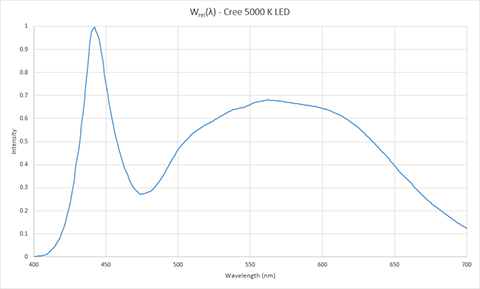
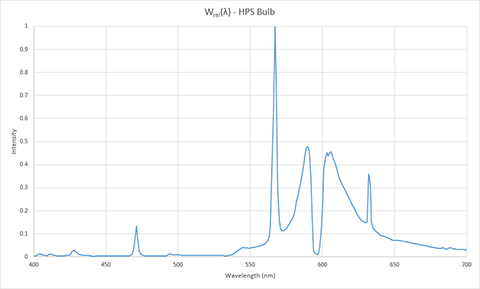
Figures 1 and 2
Luminosity function:
Light spectrum diagrams are typically provided between 400 nm (blue end) and 700 nm (red end). This range is the visible light spectrum. It's the range the human eye can see and also the general range of light that plants use for photosynthesis.
However the human eye doesn't have constant sensitivity across this range. Some smart folks back in 1931 determined what the average human response is and published the CIE 1931 Luminous Efficiency Function, fig 3. The importance of this graph is that when talking about 'lumens' one is talking about light the human eye can see. Thus the luminious efficiency function is important to work in somehow.
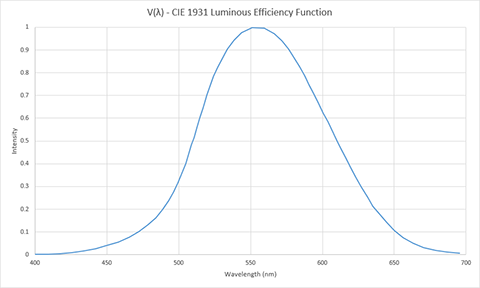
Figure 3
The luminosity function has a peak at approximately 555 nm. In order words the light we best perceive, it's a green type of light.
Important to note: light at this frequency is the reference for the unit of measure lumen, being 683 lumens per watt of light power. It's a bit of an odd value but it's the reference.
What does the human eye see?
Actually not too complicated to work out, just multiple the spectrum by the luminiosity function. Or in other words, for each wavelength value multiply the spectrum magnitude by the luminosity function magnitude.
See figs. 4 and 5 for the same 5000 K white Cree LED and sample HPS bulb. (These are intentionally not referenced to 1.0 for the wavelength with the maximum magnitude value, to provide a feel for how it would be perceived.)
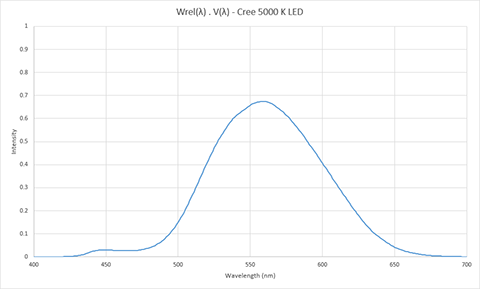
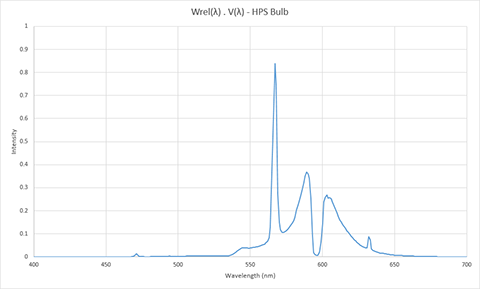
Figures 4 and 5
What is Photosynthetically Active Radiation (PAR)?
The electromagnetic radiation - typically between 400 and 700 nanometers (nm) - that photosynthetic organisms (read: plants) are able to use in the process of photosynthesis.
What is Photosynthetic Photon Flux (PPF) / Photosynthetic Photon Flux Density (PPFD)?
This is a measure of how many photons - within the useful 400-700 nm range - that are hitting a surface. This is measured for a 1 m2 surface, per second. So PPF is a measure of the PAR.
As there can be a lot of photons involved, a conversion factor is involved - the mole (mol). One mole is represented by the Avogadro constant NA = 6.022 * 10e23. That's quite a lot! However there aren't generally that many photons hitting a 1 m2 surface per second and so the PPF is measured in umol, i.e., one millionth of 6.022 * 10e23, or 6.022 * 10e17 photons. Still quite a few...
Difference between PPF and PPFD? There is none. By definition a flux value means how many "things" hitting or going through a surface, therefore "density" is superfluous.
Energy of a photon:
The enery of a photon is given by the equation:
E = h * c / wavelength
where h and c are two constants:
h = Planck's constant = 6.626 * 10e-34 Js
c = Speed of light = 3.00 * 10e8 ms-1
For a mole's worth of photons this becomes:
E = NA * h * c / wavelength
Turning this around because we know the power and want to know how many mols of photons:
PPF = E * wavelength / NA * h * c
Calculating what's desired:
Photosynthetic Photon Flux:
Roughly speaking then, the idea is to convert the lamp power, which is quoted in lumens, and with a particular light spectrum, into the number of photons.
Over the 400 to 700 nm light wavelength range:
1. Multiply the lamp spectrum by the luminosity function at each wavelength.
2. Sum all step 1 values.
3. Divide the light spectrum at each wavelength by (683 * step 2 value) <= radiant light power at each wavelength, per lumen
4. Multiple all step 3 values by wavelength <= takes into account the different energy a photon has at a particular wavelength.
5. Sum all step 4 values.
6. Multiply step 5 value by the lamp's rated lumen output.
7. Divide step 6 value by:
a. Avogadro's constant = 6.022 * 10e23
b. Planck's constant = 6.626 * 10e-34
c. Speed of light = 2.998 * 10e8
The small print: it's easiest to have the wavelengths in nm values and the desired value is in umol. Assuming this, multiply the value by 0.001 to achieve the desired end result.
(A combination of wavelengths in nm and PPF in umol.)
8. Et voilà - the PPF value in umols-1m-2.
Spectral power output - the radiant energy of the light (W):
1. Sum all step 3 values from above <= total radiant light power, per lumen
2. Multiply by the lamp's rated lumen output.
3. The spectral power output in watts.
Luminous efficiency - ratio of power in that is emitted as light (%):
1. Divide the spectral power output by the input electrical power.
2. Multiply by 100 and the result is the luminous efficiency as a percentage.
Luminous efficacy - ratio of lumens out versus electrical watts in (lm/W):
The easiest calculation last...
Divide input power by output power, e.g.,
Input power = 180 W
Output power = 22500 lm
Efficacy = 125 lm/W
Miscellaneous:
Obvious question 1:
- Where does all the energy go?
For the LED lamp used in this example, the luminous efficiency indicates that approximately 40% becomes light and the other 60% is transformed into heat. A comparative example for the HPS is a luminous efficiency of 35% (35% light / 65% heat).
The numbers will vary for any particular lamp, the efficiency definitely varies within and without each type.
Take away: Absolutely ignore any brand/seller that states, for example, a (electric) power input of 100 W and claims a (light) power output of 400 W. It's just not possible.
Obvious question 2:
- How to take a plot and do something numerically?
It's possible to get tables of numerical values for both the CIE 1931 luminosity function and a lamp or bulb. The latter typically requires contacting the manufacturer.
The alternative is to take a decent quality graph and create a table of values using software, for example Engauge Digitizer.
Worksheet:
Available here - lamp_output_calculations.xlsx
It's really not that complicated, but trying to source the information in one place / article can be difficult. Coupled with a lot of large gaps in explanations, or even plain misinformation. Hopefully it's useful...
Overview:
What this post should answer:
- What is Photosynthetically Active Radiation (PAR)?
- What is Photosynthetic Photon Flux (PPF) / Photosynthetic Photon Flux Density (PPFD)?
- How to convert lumen output to PPF.
- Why to steer clear of any brand/seller making claims that just don't add up.
What this post likely won't answer:
- Should I buy a grow lamp of one technology in preference of another?
- What is the best "colour" for growing chilli plants; for growth, for flowering, for fruiting?
- Any variation of the above that you can think of: red vs. blue LEDs, HPS vs. LEDs, what about green light, etc.
So strap on your favourite propeller hat, grab your spreadsheet application and on with the show...
"Problem" statement:
Input:
1. Rated (electric) input power of lamp - watts
2. Rated (light) output power of lamp - lumens
3. Spectrum of lamp
Output:
4. Photosynthetic photon flux (PPF)
3. Spectral power output
2. Luminous efficiency
1. Luminous efficacy
The basics:
Units of measure:
- Power is measured in watts (W). It is the amount of energy transferred per second (s).
(- Energy is measured in joules (J). It's one and same thing as power on a per second basis.)
- For this posting's purpose, power/energy can be transferred by electric current (electrons) or light (photons).
- Energy cannot be created or destroyed, just transformed / transferred - Law of Conservation of Energy.
- Red light has a longer wavelength, while blue light has a shorter wavelength. Also, red light photons have a lower energy than blue light photons. Conversely more red light photons are required to deliver the same power as blue light photons.
- Lumen is the power output from a lamp, referenced against the human eye. In other words it's how much electromagnetic radiation there is in the human visual spectrum.
- "Temperature" of a lamp is an approximation for its light spectrum compared to a black body radiator of that temperature, measured in kelvins (K).
(- Don't worry in particular about what a black body radiator is other than 2700 K is more red, 6500 K is more blue and 5700 K is a clear sky day with the sun directly overhead.)
Spectral output:
One can find the light spectrum of a lamp in it's specification sheet. See fig. 1 for a 5000 K white Cree LED and fig. 2 for a sample High Pressure Sodium (HPS) bulb.
The spectral output normally has the largest magnitude wavelength value referenced to 1.0. So a spectrum diagram doesn't tell you anything directly about how much light it produces, just what type of relative light it produces, i.e., it's spectral content.


Figures 1 and 2
Luminosity function:
Light spectrum diagrams are typically provided between 400 nm (blue end) and 700 nm (red end). This range is the visible light spectrum. It's the range the human eye can see and also the general range of light that plants use for photosynthesis.
However the human eye doesn't have constant sensitivity across this range. Some smart folks back in 1931 determined what the average human response is and published the CIE 1931 Luminous Efficiency Function, fig 3. The importance of this graph is that when talking about 'lumens' one is talking about light the human eye can see. Thus the luminious efficiency function is important to work in somehow.

Figure 3
The luminosity function has a peak at approximately 555 nm. In order words the light we best perceive, it's a green type of light.
Important to note: light at this frequency is the reference for the unit of measure lumen, being 683 lumens per watt of light power. It's a bit of an odd value but it's the reference.
What does the human eye see?
Actually not too complicated to work out, just multiple the spectrum by the luminiosity function. Or in other words, for each wavelength value multiply the spectrum magnitude by the luminosity function magnitude.
See figs. 4 and 5 for the same 5000 K white Cree LED and sample HPS bulb. (These are intentionally not referenced to 1.0 for the wavelength with the maximum magnitude value, to provide a feel for how it would be perceived.)


Figures 4 and 5
What is Photosynthetically Active Radiation (PAR)?
The electromagnetic radiation - typically between 400 and 700 nanometers (nm) - that photosynthetic organisms (read: plants) are able to use in the process of photosynthesis.
What is Photosynthetic Photon Flux (PPF) / Photosynthetic Photon Flux Density (PPFD)?
This is a measure of how many photons - within the useful 400-700 nm range - that are hitting a surface. This is measured for a 1 m2 surface, per second. So PPF is a measure of the PAR.
As there can be a lot of photons involved, a conversion factor is involved - the mole (mol). One mole is represented by the Avogadro constant NA = 6.022 * 10e23. That's quite a lot! However there aren't generally that many photons hitting a 1 m2 surface per second and so the PPF is measured in umol, i.e., one millionth of 6.022 * 10e23, or 6.022 * 10e17 photons. Still quite a few...
Difference between PPF and PPFD? There is none. By definition a flux value means how many "things" hitting or going through a surface, therefore "density" is superfluous.
Energy of a photon:
The enery of a photon is given by the equation:
E = h * c / wavelength
where h and c are two constants:
h = Planck's constant = 6.626 * 10e-34 Js
c = Speed of light = 3.00 * 10e8 ms-1
For a mole's worth of photons this becomes:
E = NA * h * c / wavelength
Turning this around because we know the power and want to know how many mols of photons:
PPF = E * wavelength / NA * h * c
Calculating what's desired:
Photosynthetic Photon Flux:
Roughly speaking then, the idea is to convert the lamp power, which is quoted in lumens, and with a particular light spectrum, into the number of photons.
Over the 400 to 700 nm light wavelength range:
1. Multiply the lamp spectrum by the luminosity function at each wavelength.
2. Sum all step 1 values.
3. Divide the light spectrum at each wavelength by (683 * step 2 value) <= radiant light power at each wavelength, per lumen
4. Multiple all step 3 values by wavelength <= takes into account the different energy a photon has at a particular wavelength.
5. Sum all step 4 values.
6. Multiply step 5 value by the lamp's rated lumen output.
7. Divide step 6 value by:
a. Avogadro's constant = 6.022 * 10e23
b. Planck's constant = 6.626 * 10e-34
c. Speed of light = 2.998 * 10e8
The small print: it's easiest to have the wavelengths in nm values and the desired value is in umol. Assuming this, multiply the value by 0.001 to achieve the desired end result.
(A combination of wavelengths in nm and PPF in umol.)
8. Et voilà - the PPF value in umols-1m-2.
Spectral power output - the radiant energy of the light (W):
1. Sum all step 3 values from above <= total radiant light power, per lumen
2. Multiply by the lamp's rated lumen output.
3. The spectral power output in watts.
Luminous efficiency - ratio of power in that is emitted as light (%):
1. Divide the spectral power output by the input electrical power.
2. Multiply by 100 and the result is the luminous efficiency as a percentage.
Luminous efficacy - ratio of lumens out versus electrical watts in (lm/W):
The easiest calculation last...
Divide input power by output power, e.g.,
Input power = 180 W
Output power = 22500 lm
Efficacy = 125 lm/W
Miscellaneous:
Obvious question 1:
- Where does all the energy go?
For the LED lamp used in this example, the luminous efficiency indicates that approximately 40% becomes light and the other 60% is transformed into heat. A comparative example for the HPS is a luminous efficiency of 35% (35% light / 65% heat).
The numbers will vary for any particular lamp, the efficiency definitely varies within and without each type.
Take away: Absolutely ignore any brand/seller that states, for example, a (electric) power input of 100 W and claims a (light) power output of 400 W. It's just not possible.
Obvious question 2:
- How to take a plot and do something numerically?
It's possible to get tables of numerical values for both the CIE 1931 luminosity function and a lamp or bulb. The latter typically requires contacting the manufacturer.
The alternative is to take a decent quality graph and create a table of values using software, for example Engauge Digitizer.
Worksheet:
Available here - lamp_output_calculations.xlsx
